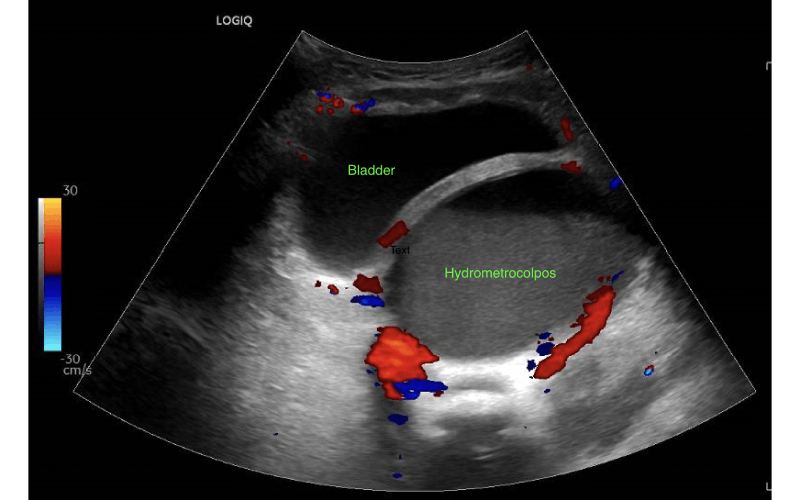When a young girl came in to the emergency department at NewYork-Presbyterian Morgan Stanley Children’s Hospital presenting with urinary retention, Soo Jeong Kim, MD, a pediatric urologist at NewYork-Presbyterian and Columbia, consulted on the case. “In managing her care, we obtained a renal bladder ultrasound that showed she had a considerable amount of urine in the bladder as well as dilated kidneys. More unusually, she had a large, dilated structure behind and separate from the bladder, that was filled with dense fluid. These could be a key finding for hydrometrocolpos, a condition that is seen infrequently in clinical practice,” says Dr. Kim. “Managing this patient’s care prompted us to explore the current literature in the field and prepare a comprehensive reference for other physicians who are confronted with this rare disorder.”

Renal bladder ultrasound showing hydrometrocolpos.
Hydrometrocolpos is characterized by the accumulation of fluid that causes a distended vagina and uterus, typically from a distal vaginal obstruction. The mucoid liquid is secreted by glands of the reproductive tract due to hormonal stimulation or may be a buildup of urine via a fistula or sinus. This condition can present in infants through adolescents. Hydrometrocolpos can be due to a range of conditions, including an imperforate hymen, cloacal malformation, or congenital abnormalities or following trauma or injury to the genital area.
Early Diagnosis and Treatment is Essential
According to Dr. Kim and her colleagues, diagnosing and treating this condition as early as possible is critical to avoid serious complications that could affect several organ systems. Their review article, published in Current Urology Reports, incorporates a comprehensive compilation from definition of the disease and etiology, to pathophysiology and clinical presentation, as well as diagnostic and management techniques and outcomes.
“To this end, we culled all the current literature on hydrometrocolpos in the pediatric population over the past five years with a focus on key clinical practices that could improve management and outcomes,” says Dr. Kim. “We identified 26 case reports and five case series published between 2018 and 2023, with a total of 69 cases of hydrometrocolpos.”
Following are key elements highlighted in the review article:
- Neonates and Infants
A prenatal diagnosis of hydrometrocolpos can be made with imaging, facilitating preparation for postnatal care. “We would likely be able to detect hydrometrocolpos on prenatal imaging, for example, if there is a dilated structure behind the bladder,” says Dr. Kim. “The obstetricians alert us that this is something they are concerned about, and we can then follow the infants after delivery.”
The authors note that some 80% of patients are younger than three months with a universal presentation of abdominal distension and lower midline abdominal mass. With no path for outflow of the retained fluid, significant sepsis can result. Complications arising from abdominal mass may lead to respiratory distress, renal dysfunction, urinary retention, or constipation and obstruction. - Adolescents
Retained fluid in prepubertal girls is generally comprised of vaginal and cervical secretions. As girls begin menarche, the retained fluid is largely blood. The most common symptoms include abdominal pain, voiding dysfunction, and back pain. Patients in puberty may experience amenorrhea, infertility, or inability to engage in intercourse. “Hydrometrocolpos usually presents in adolescence when girls are getting their periods,” notes Dr. Kim. “Examination related to a delayed first menstrual cycle generally reveals a bulging hymen, which is unusual at this age.” - Optimizing Care
Draining the retained fluid is the immediate goal to relieve the obstruction and prevent sepsis. The collaboration of pediatric surgeons, gynecologists, urologists, radiologists, and pediatricians is key to the assessment and development of operative or nonoperative treatment plans tailored to each patient. The severity of symptoms and causes of obstruction will inform the treatment approach. The goal of treatment is to decompress the dilated vagina and surgically correct the outflow obstruction. Patients who present with urinary retention, severe constipation, renal insufficiency, sepsis, or respiratory distress require urgent intervention.
According to the authors, “Many children, particularly those with less severe types of obstruction, have no long-term complications. However, children who require complex surgical reconstruction and those with associated congenital syndromes, have the potential for lifelong difficulties with bowel and bladder function, renal function, sexual function, and reproductive health.”
Dr. Kim adds, “While the cause, diagnostic approach, and management of hydrometrocolpos are recognized, there is scant research on the condition. A number of features would benefit from study, including the long-term physical, psychological, and reproductive issues in patients with hydrometrocolpos."




